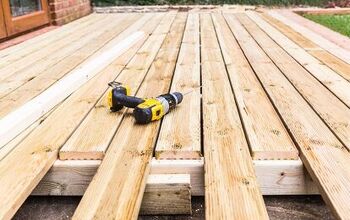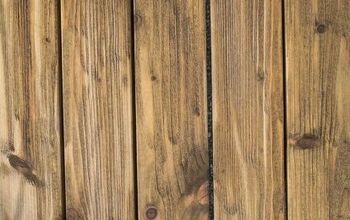Can You Burn Pressure-Treated Wood? (Find Out Now!)

After cleaning up at home and getting rid of several items, you may be left with a big stack of wood. To be more specific, you may find several planks of pressure-treated wood. You obviously don’t want those old pieces of wood cluttering up your home so you must dispose of them.
But how should you dispose of old pieces of pressure-treated wood? Some homeowners may be thinking of burning them. That is not a good idea, however.
Pressure-treated wood has been specially preserved using different toxic chemicals. If a piece of pressure-treated wood is burned, all those chemicals are released and they could harm you. Also, note that burning pressure-treated wood is illegal and you might face serious penalties if you’re caught.
Homeowners need to be aware of how to handle pressure-treated wood properly. Let’s learn more about the consequences of burning pressure-treated wood and other relevant topics by reading on.
Is It Safe To Burn Old Pressure Treated Wood?
There’s a good chance that you have items made out of pressure-treated wood currently on your property. For instance, wooden fences are often made out of the aforementioned material.
Pressure-treated wood is often used for fences because they are remarkably durable. More specifically, they hold up better against the elements and the little critters known to prowl around backyards.
You can bank on those fences made from pressure-treated wood lasting for up to 40 years assuming proper maintenance. Even when used to create a new outdoor deck, pressure-treated wood can remain in good condition for 10 years.
It’s easy to see why so many homeowners and builders fell in love with pressure-treated wood. However, there is a notable downside to using them. When the time comes for you to dispose of the wood, you may find yourself with a bit of a problem. You see, pressure-treated wood cannot be burned. Or rather, it shouldn’t be burned.
First off, there are laws in place that make burning pressure-treated wood illegal. You could run afoul of them by setting up a bonfire kindled with pressure-treated wood on your property. Even if it were legal, burning pressure-treated wood is still not a good idea. Pressure-treated wood planks have been infused with a cocktail of numerous chemicals. Once a plank has been burned, all of those chemicals are released into the air.
As you can imagine, chemicals spreading through the air is not good for anyone. Avoid that hazardous occurrence altogether by keeping the pressure-treated wood far away from any fire.
Chemicals in Pressure-Treated Wood
To better understand why burning pressure-treated wood is so dangerous, you should know which chemicals are used to preserve it. The first chemical you must know about is chromatic copper arsenate or CCA.
Arsenic is known for being a toxic substance, but that’s not even the most concerning part. The real issue is that it’s also a carcinogen. Basically, you could be unleashing plenty of carcinogens into the air the moment you start setting pressure-treated wood on fire. Along with being incredibly difficult to deal with right away, the vapors from the wood may continue to harm you long-term.
You may find that some pieces of pressure-treated wood are infused with different chemical combinations. Instead of using chromatic copper arsenate, the manufacturers may have opted for ammoniacal copper quaternary. Although ammoniacal copper quaternary isn’t as life-threatening as chromatic copper arsenate, it remains highly toxic. You do not want to be exposed to it for any length of time.
Other chemicals that may be used in pressure-treated wood include copper azole and micronized copper azole. As much as possible, you should also avoid being exposed to those chemicals.
How Can You Tell That Wood Is Pressure-Treated
Let’s say that you have some old planks lying around your yard. You want to dispose of them, but you’re not sure what you’re dealing with. How can you check if you’re holding pressure-treated wood or something else? There are some things you can look for that can clue you into what you have.
Start by inspecting the color of the wooden plank. It is subtle, but pressure-treated wood often features a kind of greenish tint. Set it next to something you know isn’t made out of pressure-treated wood and you should see the color disparity.
You can also look for small cuts along the sides of pressure-treated wood. Those small cuts served as the entry points for the chemical preservatives.
If the plank of wood you’re holding features those telltale signs of being pressure treated, make sure you handle it carefully. If you’re unsure of what you have, err on the side of caution and keep the wood away from the fire.
How Should You Dispose of Pressure Treated Wood?
Since burning pressure-treated wood is out of the question, how should you dispose of it? The only real option you have is to let the professionals handle it.
Go online and look up the landfills or disposal centers in your area. After finding them, contact them and ask if they can handle pressure-treated wood. Not all landfills and disposal centers accept pressure-treated wood, especially if you don’t inform them ahead of time. Reach out to them first.
Upon finding a landfill that will handle your hazardous waste, drive there and hand over the wood in person. They may ask you to pay a fee because of what you need disposed, but it beats putting people in danger.
How Should You Handle Pressure-Treated Wood?
Transporting pressure-treated wood to the landfill must be done carefully. Keep in mind that older pieces of pressure-treated wood can be more dangerous. Handling them properly is essential if you want to avoid getting sick.
Here in this section, we’ll discuss how you should handle pressure-treated wood. Note the reminders below and you should be able to avoid any serious issues.
Keep the Pressure-Treated Wood Outside
You may not be able to transport the pressure-treated wood right away. In that case, you’ll have to store it properly on your property in the meantime. Keeping the pressure-treated wood indoors is a huge no-no because any chemicals released could linger in the room. You must keep the pressure-treated wood outside.
Prepare two tarps. Use one to cover the ground and arrange the pieces of pressure-treated wood on top of it. Take the other tarp and drape it on top of the wood. You should also avoid letting your pets or kids into the yard while the pile of pressure-treated wood is there. They may get exposed to the hazardous chemicals in the wood if they get too close.
Wear Protective Gear Whenever You Handle the Pressure-Treated Wood
Those dangerous chemicals infused in the pressure-treated wood may start leaking while you’re handling the planks. Protect yourself better by wearing certain items. At a minimum, you should wear thick gloves and clothing that covers most of your skin while handling the wood. Consider wearing some overalls to get some added protection.
Some planks of wood may be too big to fit in your car. You will have to cut them down to size first. Before cutting the pressure-treated wood, put on some safety goggles and a respirator. The safety goggles will stop wood from hitting your eyes while the respirator keeps you from inhaling any toxic fumes.
Clean Up Thoroughly after Disposing of the Pressure-Treated Wood
Once you get home after disposing of the pressure-treated wood, take the time to clean up thoroughly. Wash your clothes properly to get rid of any chemical residue. You should also clean up your yard.
Don’t forget about your vehicle. Take the time to clean that as well to ensure that no harmful chemicals have been left behind.
Related Questions
Can You Use Sawdust and Chips from Pressure-Treated Wood in Compost Heaps?
Many DIYers like to save the sawdust and wood chips leftover once they’re done with a project. Those leftover materials can actually be quite useful as they can be used to enrich compost heaps.Unfortunately, you cannot do the same thing with the remnants of pressure-treated wood. Any leftover materials you gather from those preserved planks should be disposed of safely instead of being reused. Those small pieces of pressure-treated wood still contain traces of toxic chemicals. Add them to the compost heap and they could just destroy what you’ve put together.
How Can You Tell if You’ve Been Exposed to the Fumes of Burning Pressure-Treated Wood?
Your neighbor may be burning pressure-treated wood. If that’s the case, you may start to feel nauseous and develop a sore throat. Those are the minor symptoms. In more severe cases of arsenic poisoning, victims may develop irritated lungs. They may also start to notice that their limbs are going numb.Report anyone who you suspect has been burning pressure-treated wood to the authorities. They are putting you and your family in danger so put a stop to them immediately.

Gary Evans is passionate about home improvement. He loves finding out how to make improvements in the easiest, most practical, and most affordable ways. Upgrading his home kitchen is one of his ongoing hobbies. Gary is also a long-time content creator and enjoys spending his free time tending to his hydroponic vegetable garden.
More by Gary Evans



























